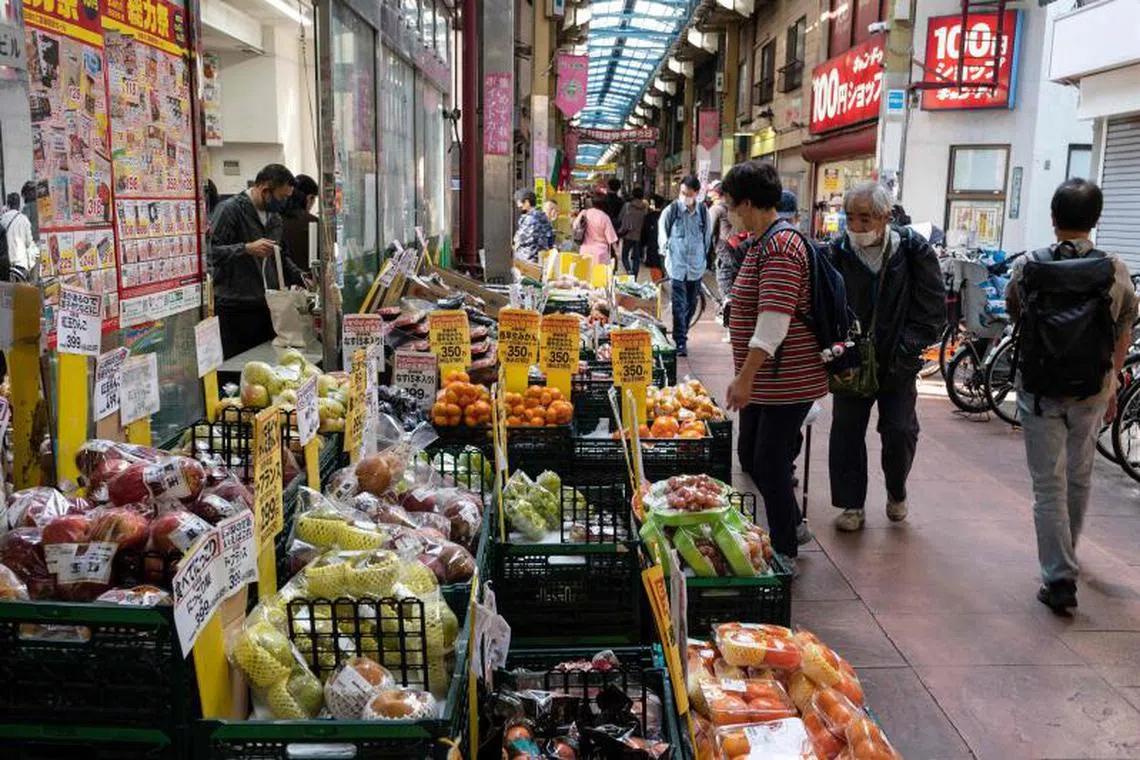Japan inflation hits 40-year high in test of BOJ resolve
Sign up now: Get ST's newsletters delivered to your inbox

The Bank of Japan currently expects price growth to weaken to below 2 per cent in the next fiscal year starting in April.
PHOTO: AFP
Follow topic:
TOKYO - Japan’s inflation hit its fastest clip in 40 years in October as a weak yen pushed up the cost of imported commodities, further stretching the credibility of the central bank’s view that continued stimulus is needed for stable price growth.
Consumer prices, excluding fresh food, climbed 3.6 per cent in October from a year earlier, with the acceleration driven by processed food and the fading impact of mobile phone fee cuts, the Internal Affairs Ministry reported on Friday.
This is the fastest price growth since 1982. Core inflation has now exceeded the Bank of Japan’s (BOJ) 2 per cent price target for seven straight months, with the yen’s historic fall amplifying the trend.
Following the statement, BOJ governor Haruhiko Kuroda reiterated his view that the central bank’s ultra-low interest rates remain appropriate, although he acknowledged that the latest gains were significant and inflation could accelerate further.
While economists largely agree with the BOJ that inflation will cool in Japan in 2023, partly as a result of government subsidies, some analysts see the central bank underestimating the underlying strength of prices.
“It is getting harder for the BOJ to keep saying that the current cost-push inflation is temporary,” said Daiwa Securities chief market economist Mari Iwashita. “If the yen remains weak, more companies will try to pass on costs to consumers.”
The BOJ remains the outlier among major central banks. While his peers have long since given up the view that hot prices are merely transitory and have aggressively raised borrowing costs, Mr Kuroda has stuck resolutely with rock-bottom interest rates. This stance has helped drive the yen to 32-year lows against the greenback, prompting repeated government intervention in currency markets.
Mr Kuroda has consistently maintained that the current inflation is unsustainable and driven by import costs and the weaker currency, as he looks to keep policy on hold during the final months of his leadership. “I believe price growth will fall below 2 per cent in the next fiscal year onwards,” he said in Parliament on Friday.
The latest data shows that price rises are continuing to spread beyond energy costs. Gains in processed food costs now outweigh the impact of elevated power and fuel prices, the report showed. Excluding fresh food and energy, price growth has reached 2.5 per cent, an indication that the strength of the inflation trend is firmly beyond 2 per cent.
In October, companies raised prices on about 6,700 food items, ranging from mayonnaise to beverages, according to a Teikoku Databank survey. Although the trend appears to have peaked in October, another 833 food items, including dairy products, are expected to go up in November.
To ease the hit of higher prices on consumption, Prime Minister Fumio Kishida in October ordered an economic stimulus package that includes aid to reduce energy costs and cash handouts for childcare. Some analysts see the impact of the subsidies lowering the inflation rate by more than 1 percentage point in 2023, a factor that will mask the underlying strength of price growth.
SMBC Nikko Securities economists expect the key inflation gauge to sharply slow to around 2.5 per cent early in 2023 due to the government measures. But with the end of the support set to come in stages, price growth will probably start to accelerate again to around 3 per cent in 2024, they wrote in a report.
“When companies passed their costs on to consumers just before the global financial crisis, it did not last,” said Mr Seisaku Kameda, a former BOJ chief economist and current executive economist at Sompo Institute Plus. “I still cannot see Japan’s economy entering a virtuous economic cycle with inflation and wage growth.”
Still, the latest show of strength in prices is likely to keep speculation smouldering of a possible change of direction when a new governor replaces Mr Kuroda in April. BLOOMBERG

